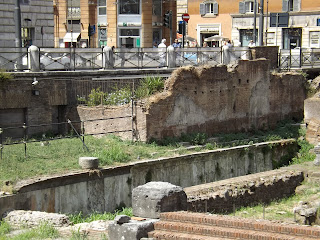Today, by special permission, we were allowed to go underneath the City Hall of Rome. The City Hall is located in a palazzo on top of the Capitoline Hill (Campidoglio), between the two palazzos that are the Capitoline Museum. This area of the Capitoline Hill is thought to have been a building known as the Tabularium. The Tabularium also enclosed an existing temple to Veiovis. More about Veiovis later.
Before the Tabularium was built, it is believed the site also was home to a temple to Juno Moneta, pictured below.
Juno Moneta (Juno the one who warns) would have been an appropriate temple to place on the Capitoline Hill, since it was the geese sacred to Juno that warned the Roman soldiers in the citadel of a sneak attack by Gauls in 387 BC.While we were waiting for the guard to come open up our super top secret area, I took advantage of the beautiful vantage point to snap some more photos of the Forum. Here is the Temple of Saturn.
The Arch of Septimius Severus.
The remaining columns of the temple to Vespasian.
All three of those together.
The columns of the Temple of Castor and Pollux, featured a few days ago.
Inside we saw the remains of a temple to Veiovis. Veiovis had shifting roles. Originally he was sort of an anti-Jupiter and a god of revenge. Later he becomes associated with healing and in this role another temple was built to him on Tiber Island which was a center of healing and medicine in Ancient Rome.
After our visit underneath City Hall, we walked to the Largo di Torre Argentina. During Mussolini's reign in Italy, he razed some apartment buildings with the intent to create a traffic circle. As the demolished the apartments, they found the remains of four ancient temples underneath. Below is a panoramic photo of the site.
At the right of the site is Temple A, thought to be a Temple of Juturna. I covered Juturna a few days ago in the blog.
The next temple, Temple B, is a Temple of Fortuna. Notice that this is a round temple.
Temple C, the third temple, is believed to have been a Feronia, a native Italian goddess of fertility.
Temple D, the last of this group, is only partially excavated. It is thought to have been a temple for the Lares Permarini. Lares were the Roman equivalent of "guardian angels." The Lares Permarini were those Lares who looked after all sailors.
Marcellus was the nephew of Augustus and was believed to have been Augustus' planned heir. He died at an early age and Augustus built this theater in his honor. Above the remains of the theater are apartments. According to our professors, this is some of the most expensive real estate in Rome.














No comments:
Post a Comment